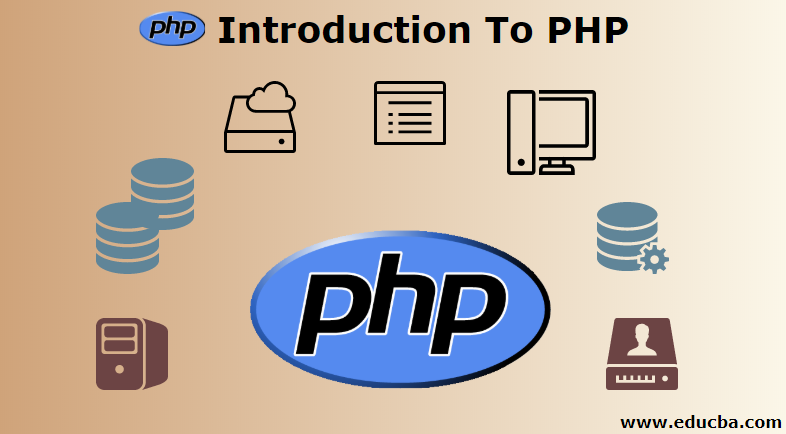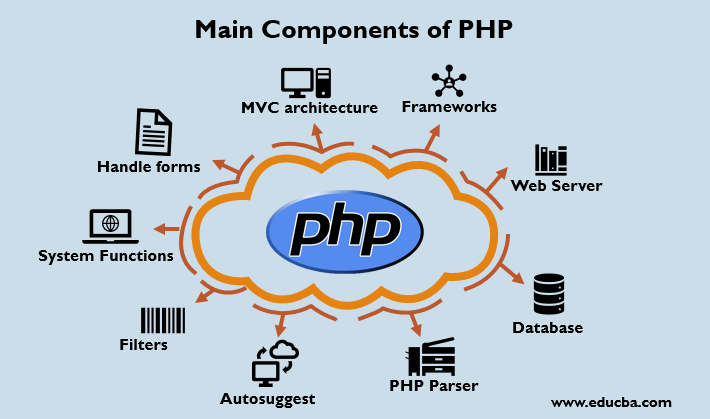Updated March 8, 2023
Introduction to PHP
The following article provides an outline for Introduction to PHP. PHP is also known as Hypertext Pre-processor. PHP is an open-source and server-side scripting language, which is mainly used for developing web applications. The syntax of the PHP language is similar to the C language. PHP was originally created by Rasmus Lerdorf, and it first appeared in 1995. PHP is widely used in developing web applications and has become one of the major languages for the developers to create new applications.
Main Components of PHP
Given below are the main components of PHP:
- MVC Architecture: PHP mainly works on model-view architecture that helps in managing the code and separate the model, view, and controller files. It helps in connecting the database very easily, and the changes can be done easily without affecting other files or modules.
- Frameworks: PHP has different frameworks that are Aura, Yii, Symfony, Laravel, and Zend. The frameworks help in achieving neat and clean code, are manageable, and make the development easier for the developers.
- Web Server: PHP is mainly worked on webserver software and used the Apache server.
- Database: PHP can be used with any database, but it is mainly used with MySQL.
- PHP Parser: Parser helps in parsing the PHP instructions to HTML code and then send it to a web browser to display the content.
- Autosuggest: In this introduction to PHP, the components are ready to use to implement the search form with an autosuggest feature using PHP and database MySQL.
- Filters: In PHP, Filters are used to validate the data using the filter function. This filter function helps in checking the invalid input that has been submitted to avoid the security problem and break of web pages.
- System Functions: In PHP, the system functions are performed to open the file. It also helps in creating, reading, and writing the file as well.
- Handle Forms: In PHP, the forms are handled and able to get the data from files, save the data, sending the email and return data to a user. PHP can encrypt the data and is able to access and set the cookie variable. With the help of PHP, a developer can restrict the user from accessing the pages.
Characteristics of PHP
Given below are the characteristics mentioned:
- It is simple and easy to use.
- It is efficient and able to connect the database and load the application faster.
- It provides more security to the web application with the help of using PHP frameworks.
- It is more familiar for the developers, and online support is being provided for beginners.
- It shows flexibility and the ability to get integrated with another programming language.
- It is open-source and free of cost.
- It is lightweight, and number of frameworks available to use for developing the web application.
- It helps in achieving the development of web applications quickly.
Application Based on PHP
PHP is being used widely in developing web-based and other applications across all the domains.
Some of the technology based on which PHP applications are developed listed below:
- Content management system
- Web-based applications and development of web pages
- E-commerce websites and applications.
- Data analytics and representation
- Processing of images.
- Graphical user interface design-based applications
- Developing the features of flash
- Graphic designing
- Small enterprise applications
- School and college websites
- Conversion of files into other
- Small video games
Advantages and Disadvantages of PHP
Given below are the advantages and disadvantages mentioned:
Advantages
- The most important advantage of PHP is that it is open-source and free of cost. It can be downloaded anywhere and readily available to use for the development of web applications.
- It is platform-independent. PHP-based applications can run on any operating system like UNIX, Linux, and windows, etc.
- The PHP-based application can easily be loaded and connected to the database. It is mainly used because of its faster rate of loading over the slow internet and speed than another programming language.
- It has less learning curve, as it is simple and easy to use. If an individual knows, C programming can easily work on PHP.
- It is more stable for many years with the help of providing continuous support to the different versions.
- It helps in reusing the same code, and no need to write lengthy code and complex structure for the development of web applications.
- It helps in managing the code easily.
- It has powerful library support to use the different function modules for data representation.
- PHP’s built-in database connection modules help in connecting the database easily reduce the effort and time for the development of web applications and content-based sites.
Disadvantages
- It is not that secure because of its open-source, as the source code can be easily available.
- It is not suitable for large content-based web applications.
- It has a weak type, which may lead to incorrect data and information to the user.
- PHP frameworks need to learn to use the PHP built-in functionalities to avoid writing additional code.
- Using more features of PHP framework and tools leads to poor performance of the web applications.
- PHP does not allow the change or modification in the core behavior of the web applications.
- The PHP frameworks are not the same in behavior so does their performance and features.
Conclusion – Introduction to PHP
PHP is the most widely used programming and server-side scripting language for the development of web-based applications. Overall overview, components, characteristics, applications, advantages, and disadvantages are described above in this introduction to PHP post. In some areas, PHP is the best for developing small applications and for developers having financial issues. They can easily use this language, which is readily available and develop the application based on their requirements. Introduction to PHP is being popular language having great online support and a community to help beginners. It is purely based on the trends or requirements for which programming language an individual has to go for the development of any application.
Recommended Articles
This has been a guide to Introduction to PHP. Here we have discussed the basic concept, main components, characteristics, advantages, and disadvantages of PHP. You may also look at the following article to learn more –



